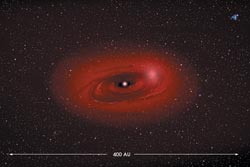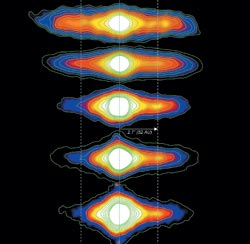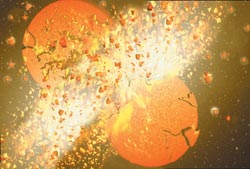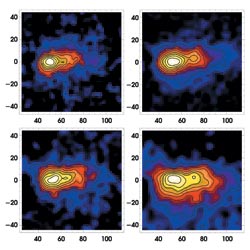Daniel S. Burgess, Senior Editor
In the two decades since the Infrared Astronomical Satellite mission revealed the presence of a dust disk around Beta Pictoris, astronomers have turned to the main sequence star for clues to better comprehend how our own solar system came to be. Now an international team of scientists has used a mid-IR camera at the 8-m Gemini South telescope 9000 feet up in the Chilean Andes to collect images of what may be the remnants of a recent collision of planetesimals in the circumstellar disk.

The disk of dust surrounding Beta Pictoris features an anomalous bright region in the mid-infrared roughly 52 AU from the star. Image by Jon Lomberg. Courtesy of Gemini Observatory.
Charles M. Telesco, a professor of astronomy at the University of Florida in Gainesville and the lead author of a paper in the Jan. 13 issue of Nature reporting the observations, said that Beta Pictoris has the right characteristics to test theories of the early lives of planetary systems. It is relatively nearby, at approximately 60 light-years, which makes it bright and easy to observe with detail; it is tilted only slightly with respect to Earth, which reveals details in its disk; and it is young for a star of its type at 10 million to 20 million years, the early limit of the age at which our own solar system is believed to have formed planets.
In our current understanding of planetary development, Telesco explained, the gas and dust in the circumstellar disk that forms as the system takes shape coalesce over time into planetesimals 1 to 1000 km in diameter. These planetesimals collide and accrete into larger bodies — planets — and in the process generate excess material that falls onto the star or is ejected into interstellar space.
But the process does not end there. Although the initial cloud of gas and dust goes into forming the star and its satellites or is blown off into space, collisional events in the system continue to occur, generating more debris of various sizes. Such relatively late collisions have been proposed to explain the origin of Earth’s moon and the zodiacal cloud, a disk of dust in the inner solar system fed by the breakup of planetesimals in the asteroid belt between Mars and Jupiter and by cometary material.
It is the trace of this sort of late collisional event that the astronomers from the University of Florida, Gemini Observatory Northern Operations Center in Hilo, Hawaii, the Royal Observatory in Edinburgh, UK, and Gemini Observatory Southern Operations Center and Cerro Tololo Inter-American Observatory, both in La Serena, Chile, may have observed.

Using the thermal region camera and spectrograph at the 8-m Gemini South telescope, astronomers resolved the asymmetry in the circumstellar disk. From top to bottom, the images were collected at wavelengths of 24.6, 18.3, 12.3, 11.7 and 8.7 μm. ©Nature Publishing Group.
Over six nights in December 2003 and January 2004, they trained the thermal region camera and spectrograph, an instrument built by the university for Gemini South, on Beta Pictoris to investigate an asymmetrical feature in the circumstellar disk approximately 52 AU from the star. At such a distance, Telesco said, the region may be interpreted to be the equivalent of the Kuiper Belt in our solar system, a ring of primitive planetesimals beyond the orbit of Neptune.
The spectrograph incorporates a 320 × 240-pixel Si:As impurity band conduction detector optimized for imaging and spectroscopy in the 8- to 26-μm mid-IR spectral region. To compensate for the thermal emissions from the telescope (even from a low-emissivity instrument such as Gemini South) and IR noise from the atmosphere, chopping and nodding techniques rapidly compare the signal from the astronomical source with that of the adjacent sky, Telesco said. In addition, to minimize thermal radiation from the detector and its immediate environment, the instrument is cooled to 8 K.

Presuming the material on either side of the disk is the same and given the radiation pressure exerted by Beta Pictoris, the anomaly may represent submicron dust grains produced by the collision of planetesimals a mere 50 years ago. Image by Jon Lomberg. Courtesy of Gemini Observatory.
The astronomers found that the anomaly is particularly bright at the shorter wavelengths at which they imaged — 8.7, 11.7, 12.3 and 18.3 μm — and used these observations to calculate that it is generated by material at approximately 190 K, or 50 K hotter than that at the same distance from Beta Pictoris on the opposite side of the disk. Presuming that the material on both sides is the same mix of silicates and organics, this temperature difference suggests that the signal source is dust particles five to 10 times smaller than the 1-μm grains on the opposite side, suggesting a collision of planetesimals that pulverized the equivalent of a spherical body at least 100 km in diameter.
The radiation pressure exerted by Beta Pictoris, however, would be expected to blow submicron dust out of the system at 4 to 6 km/s. Given the roughly 10- to 20-AU vertical and 40-AU radial size of the asymmetrical feature, the astronomers surmise that the event must have occurred recently — on the scale of 50 years.

To further explore the anomaly, the astronomers subtracted the signal from the fainter region at the same distance on the opposite side of the disk from that of the bright feature at wavelengths of 8.7 μm (upper left), 11.7 μm (upper right), 12.3 μm (lower left) and 18.3 μm (lower right). The X- and Y-axes represent the offset from the minor and major axes of the system, respectively, in astronomical units. ©Nature Publishing Group.
Despite the excitement inherent in catching a glimpse of such a rare event in another star system, Telesco put the work in perspective. His team and others will continue to employ mid-IR imaging to investigate the heated dust around stars, using the imaging and spectrographic device at Gemini South, the CanariCam instrument that the University of Florida is building for the 10.4-m Gran Telescopio Canarias telescope nearing completion on La Palma in the Canary Islands, and a host of other terrestrial and space-based systems.
“Our images and similar ones by other researchers are part of the slow accumulation of facts that we are weaving together to get a complete picture of the formation and evolution of planetary systems,” he said. “Ours is just one little brick in the large edifice.”